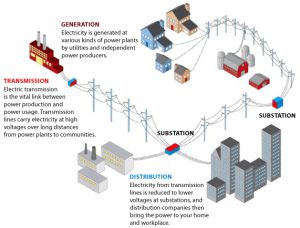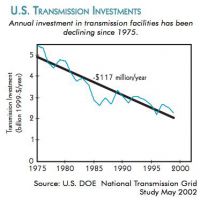Michael Elowson majored in Chemical Engineering with an Environmental focus at the Viterbi School of Engineering at the University of Southern California. His studies in sustainability sparked his interest in Smart Grid development.
The demand for power in the United States is rising every year, mostly due to population growth and the increasing use of and dependence on electronics. Our current power grid, being nearly a century old, is simply struggling to keep up. The development of a Smart Grid is a necessary improvement for this country’s infrastructure in order to increase its efficiency and reliability while lowering its costs and environmental impact.
Introduction
The United States power grid can easily be considered the largest interconnected machine on Earth. For nearly a century, our electrical infrastructure has been providing reliable power to Americans. Without it, many aspects of our lives that we take for granted would not be possible, including banking, communications, appliances, traffic signals, and the myriad of electronics we use for work and play. “Blackouts,” or temporary failures of the grid, have dire consequences, including a halt in industrial production, food spoilage, and the inability to use cell-phones or credit cards. Up until now, our nation’s power grid has been incredibly reliable, yet its stability is now becoming threatened. With the rapidly increasing population and the scope of our electronics, we are asking more of the grid than ever before. In fact, it is estimated that the United States energy demand will grow by 30% in the next ten years [1], resulting in unprecedented stress that our current grid will not be able to handle.
In order for our electrical infrastructure to remain alive and well, the development of a “Smart Grid” is of the utmost importance. In essence, a Smart Grid is an automated electrical delivery system that is able to process and transmit information on the current usage of energy throughout the entire grid. The possible benefits of such advancement for humankind are astounding. By implementing Smart Grid technology, we can save billions of dollars annually while greatly improving the efficiency, reliability, and environmental impact of our current electricity usage. The necessities and technology involved in developing a Smart Grid in the United States, as well as current steps and roadblocks regarding its implementation, are all important to explore.
The Current Power Grid in the United States
Though our nation’s power grid is an incredibly complex array of plants and lines, it is made up of three main components: generation plants, transmission systems, and distribution systems (Fig. 1). In the United States, there are over 9,200 generation plants creating over 1,000,000 megawatts of capacity, as well as 300,000 miles of transmission systems and distribution systems [2]. All three of these components utilize three-phase AC currents in order to effectively operate transformers and minimize line loss over long distances. After being generated, the three-phase power exits the generator and enters a transmission substation, where large transformers convert the generator’s voltage to an extremely high level, typically 155,000-765,000 volts. After traveling great distances, voltage is lowered at a distribution substation to standard line voltage, which is usually 7200 volts. From there, a bus splits power and sends it off to its many destinations. Upon reaching a service destination, the voltage is stepped down one last time to a required service voltage, and power becomes readily accessible [3].
Why is a Smart Grid Becoming So Necessary?
We are all familiar with power outages. Most of the blackouts we experience last for merely a few hours and are seen by many as an opportunity to bond among candlelight with family or friends. However, a blackout can quickly escalate into a national crisis, as seen in August 2003. On one hot day, a power failure that originated in Ohio left much of the eastern United States at a standstill. Over 260 power plants were shut down, leaving a staggering 50,000,000 people without power; hundreds were arrested for looting, and nine even died as a result [4]. Countless businesses, factories, and transportation and communication systems were rendered inoperable. Experts estimate that the shutdown cost around $6 billion.
Considering the construction pattern of our current power grid, it is no surprise that blackouts on such a large scale can occur at any time. Since electricity must be consumed almost immediately after it is produced, a functioning power grid must be balanced across its entirety at all times. A large failure at one end of the grid can cause current to re-route itself; putting certain transmission lines over their capacity and causing even further failures. The large-scale grids of today are thus extremely vulnerable to this domino effect, leading to “cascading failures” and extensive power outages.
Despite the growing demand for power in the United States, federal funding and investments towards electrical infrastructure are decreasing each year. This is especially true regarding electricity transmission, as only 668 miles of transmission lines out of a 300,000-mile total have been built in the last ten years [2] (Fig. 2). The result is a huge increase in “grid congestion” during peak hours, during which transmission lines are overused and the price of electricity rises. Thus, consumers are not only paying more for their power, but they are increasingly subject to outages.
Beyond the prevention of blackouts, there are numerous incentives to overhauling our nation’s electrical infrastructure. In a time of recession, it is especially important to note the vast amounts of money we are losing to our current power grid. Outages cost the United States an average of $150 billion each year, boiling down to about $500 for every American [2]. For example, Sun Microsystems estimates that a blackout costs their company $1 million every minute, and a blackout that hit the Chicago Board of Trade in 2000 resulted in the delay of $20 trillion in trades [2]. Outages damage not only our wallets but also the environment. Forty percent of all carbon emissions in the United States result from the generation of electricity. This is an incredibly high number considering that every car on the road combined accounts for only 20% of emissions [2]. Previously, the common solution to meeting increasing energy demand has been to merely build more plants, thereby burning more fossil fuels, releasing more CO2, and further damaging our environment.
There are many stakeholder groups that would greatly benefit from the implementation of a Smart Grid, including consumers, utilities, technology providers, regulators, policy makers, and environmental groups. By implementing Smart Grid technologies, we can not only protect society by preventing blackouts, but also save ourselves billions of dollars while reducing our impact on the environment.
What makes a Smart Grid “Smart?”
A Smart Grid is characterized by its use of a two-way flow of both power and real-time data at every point in the transmission and distribution process, allowing a “near-instantaneous balance of supply and demand at the device level” [2]. Whereas our current grid is left vulnerable due to slow response of switches, a deficiency of analytics, and a lack of widespread situational awareness, the Smart Grid is able to automatically manage itself using information collected each second from every corner of the grid. This is accomplished using digital two-way metering, communications systems, and rapid information processing. Phasor Measurement Units (PMU) sample current and voltage at many locations throughout the grid multiple times each second [2]. This data is used to route power along lines with the least congestion, thus shortening the gap between generation and consumption while improving efficiency. Such an elevated level of measurement and data-analysis will give operators far more insight and control over the ever-changing condition of the grid.
The Smart Grid will also utilize high-temperature superconductors, which will greatly reduce loss in power during line transmission and can carry three to five times more power than traditional copper-based cables [2]. Additionally, a promising technology currently being explored is that of thermal storage, also known as hybrid air conditioning, a method of energy storage that could further balance generation and consumption.
The Smart Grid also has very positive implications for consumers, which is vital to the economic feasibility of its implementation. Consumers will have the ability to set comfort, price, and environmental preferences for their homes. What this means is that they can preset appliances and electronics to automatically turn on when the cost of energy is lowest according to real-time supply and demand. Consumers will also be able to better integrate smaller-scale energy sources such as solar panels into the grid, as well as power their hybrid-electric cars at a price equivalent to approximately $.90 per gallon [2]. Such benefits of the Smart Grid will not only save consumers money but also motivate them to incorporate renewable energy sources into their homes and reduce their carbon footprint.
Implementing the Smart Grid
President Barack Obama has made the development of a Smart Grid a large part of his “rebuilding America” plan, as the stimulus package he signed in 2009 allocated $4.5 billion to the cause [1]. However, the development of a Smart Grid has been federal policy for several years now, in accordance with the Energy Independence and Security Act of 2007. Under this act, the National Institute of Standards and Technology (NIST) was designated with the vital first step of establishing measurement methods, interoperable technologies, and most importantly a pervasive set of industrial standards. For example, auto manufacturers must agree to plug-in standards for hybrid cars before they can be included into the Smart Grid. Other industries that require established standards include manufacturers of appliances, home electronics, and necessary communication devices, among others. Through the last couple years, the NIST has been successful in developing guidelines for Smart Grid cyber-security, data-exchange standards for electricity usage, and five “foundational” standards to ensure interoperability and uniformity of emerging Smart Grid technologies and communication systems. The NIST hopes to have fully developed standards regarding plug-in electric vehicles as well as a pervasive method of testing and certification by the end of 2011 [5].
When the necessity of a Smart Grid was first being realized, one major problem was the technology gap between what was available and the technology such a grid would require. However, the right technology is finally beginning to come around, and communications companies in particular are leading the way in developing full-scale Smart Grid platforms. In 2008, MainNet communications, a leading provider of Smart Metering and Smart Grid solutions to utility companies, released a future-proof and end-to-end Smart Metering platform. The Solo platform features under-the-glass meter interface modules (MIMs), as well as a reliable two-way broadband communication over power and two-way wireless mesh communication network. This communications network also supplies the infrastructure for other Smart Grid applications, such as in-home controls and smart appliances, among others. The network allows utilities to add applications by connecting Ethernet- or ZigBee- (a specification of high-level communication protocols, comparable to Bluetooth) based devices such as automated distribution switches or sensors.
Though MainNet’s two-way communication Smart Metering platform was a significant step for Smart Grid technology, only recently was the first and only full-scale Smart Grid Operating System released. On November 4, 2010, Grid Net, a leading provider of IP Smart Grid and Smart Home software platforms, announced the release of its second generation Universal Smart Grid Operating System, PolicyNet 2.2. PolicyNet is essentially a group of software products, which according to Grid Net Executive Vice President Andres Carvallo “provides an intelligent, reliable, real-time, all-IP, cost-effective, secure, policy-based network management system software platform, operated within the utility’s network operations center, which provides complete lifecycle management services for millions of Smart Grid Devices.” Key upgrades to the new PolicyNet Platform include improved load management and control and enhanced operational efficiency and resiliency. However, what makes PolicyNet 2.2 truly unique is its universal management, complete security, instantaneous communication speeds, open standards-based interoperability, massive scalability, and lowest total cost of ownership available [6].
While such technology is crucial to the implementation of a Smart Grid, many other driving forces in society must be on the side of grid development in the coming years in order to achieve universal application. Policy makers play an important role, particularly regarding the regulatory framework of energy production and utilities. Current regulation must be restructured in order to open more segments of the energy sector to competitive market forces in a way that increases benefits to customers, namely by giving them the ability to regulate their own usage, incorporate renewable energy sources, and ultimately save money. Furthermore, stricter environmental policies on air pollution, CO2 emissions, and land and water use must be put into place in order to provide economic incentive to utility companies to implement the Smart Grid technologies mentioned above.
Though there is some funding as well as a recognized need for a Smart Grid, there remain serious roadblocks to be overcome. This most noticeably includes the estimated $165 billion it would take to develop a nationwide Smart Grid [1], especially given an electrical industry notorious for not spending enough on research and development. There is also the issue of overcoming long-standing inertia regarding changing the energy industry, due to its historical monopoly structure and resiliency to restructuring of not only its policy, but also its overall philosophy on environmental impact, efficiency, and customer benefits. Furthermore, the lack of overlap between emerging technologies and market-based incentives for investment must be overcome in order to generate the capital necessary to implement a nation-wide Smart Grid.
Conclusion
By 2030, the United States Department of Energy (DoE) expects to have a fully functional Smart Grid up and running. This grid will hopefully include an “electricity backbone” consisting of high-capacity transmission corridors connecting different regions of the country as well as Mexico and Canada, regional interconnections to further distribute power, and localized grids to bring power to homes and businesses. These localized grids will utilize the metering and data analysis technologies discussed above, perhaps within every single node of the grid. The Smart Grid as a whole is hoped to connect all North Americans with “abundant, affordable, clean, efficient, and reliable power anytime, anywhere” [7] (Fig. 3). With cutting-edge technologies such as Grid Net’s Policy Net 2.2 being developed, as well as a highly recognized need for a smarter power grid from both an economic and environmental standpoint, it seems like we are well on our way. However, there are still many challenges to be faced, including the hundreds of billions in cost, and stagnancy in changing energy policy and regulatory framework.
In many ways, developing a Smart Grid is similar to developing the Internet. Ten years ago, no one could have dreamed that the “World Wide Web” as it was could revolutionize the way we work, play, communicate, shop, and learn to the degree it has. It is entirely possible that a Smart Grid could change the entire world to a similar degree, by allowing energy to be routed around the world the same way information is via the Internet. The possibilities and upside are simply astounding, and thus the development and implementation of a Smart Grid are not only necessary steps for our nation, but humankind as a whole.
References
-
- [1] R. Cole. “Power, and pitfalls, of a ‘smart grid’. ” Los Angeles Times, Apr. 2009.
- [2] United States of America. Department of Energy. Office of Electricity Delivery and Energy Reliability “The Smart Grid: An Introduction. Litos Strategic Communication. The Smart Grid: An Introduction. United States Department of Energy”. Internet: http://www.oe.energy.gov/DocumentsandMedia/DOE_SG_Book_Single_Pages(1).pdf, [Oct. 12, 2010].
- [3] M. Brain. “How the Power Distribution Grid Works.” Plant Engineering. Internet: http://www.lexisnexis.com.libproxy.usc.edu/hottopics/lnacademic/?shr=t&csi=169866&sr=HLEAD(How+the+power+distribution+grid+works)+and+date+is+March,%202001, 2001, vol. 55.3, pp. 104, [Oct. 12, 2010].
- [4] K. Kowalski, and M. Lusted. “BLACKOUT! ” AppleSeeds, Jul. 1, 2009, [Oct. 25, 2010].
- [5] United States of America. Department of Commerce. National Institute of Standards and Technology. NIST & the Smart Grid. Internet: http://www.nist.gov/smartgrid/nistandsmartgrid.cfm, Dec. 23, 2010, [Feb. 20, 2011].
- [6] A. Carvallo. “Grid Net Releases PolicyNet™ 2.2 Smart Grid & Smart Home Software Platform.” Grid Net. Internet: http://www.grid-net.com/pr-2010-11-04, Nov. 4, 2010, [Dec. 1, 2010].
- [7] United States of America. Department of Energy. Office of Electric Transmission and Distribution. Grid 3030. Internet: http://www.oe.energy.gov/DocumentsandMedia/Electric_Vision_Document.pdf, 2003, [Oct. 12, 2010].




